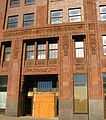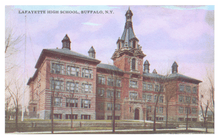James A. Johnson (architect)

James Addison Johnson (1865-1939) was a Buffalo, New York architect known for his design of various architectural landmarks and his use of decorative work that many consider a foreshadowing of art deco design.
Johnson was born and educated near Syracuse, New York. Johnson apprenticed and partnered with architects Edward Kent, Joseph Lyman Silsbee, Richard Morris Hunt, James Marling and the firm of McKim, Mead and White in New York City.
Johnson came to Buffalo in 1892 and continue his architectural practice. Significant projects from this period include the Alexander Main Curtiss House designed with partner James Marling.
After Marling's death, Johnson formed a partnership with the German born and trained architect August Esenwein. From its inception in 1897 Esenwein & Johnson was one of the most successful architectural firms of the time and is credited with the design of many buildings that have become Buffalo landmarks. These include the Niagara Mohawk Building, the United Office Building in Niagara Falls, New York, the Ellicott Square Building and various buildings for the Pan-American Exposition notably the Temple of Music (infamous as the site where President William McKinley was assassinated). Esenwein & Johnson designed many buildings for the United Hotels Company, which was the largest hotel chain in the country at the time.
Esenwein & Johnson's work was known for its diverse styles through a sixty year history of designs, executing projects in Georgian Revival, Art Nouveau and Art Deco styles. Of special note is the decorative features of Johnson's design for the 1912 Niagara Mohawk Building which foreshadowed Art Deco ornamentation.
A number of Johnson's Buffalo, New York buildings are on the National Register of Historic Places including The Calumet, Hotel Lafayette, M. Wile and Company Factory Building, Fosdick-Masten Park High School and Lafayette High School.
Johnson died in 1939 in Buffalo, New York.
Gallery
-

Temple of Music at 1901 Pan-American Exposition, Buffalo, NY
-

Nighttime photo of electrified Temple of Music.
-

United Office Building, Niagara Falls, NY. Although abandoned in this photo, it has since been renovated and re-opened.
-
Inlaid floor of Ellicott Square Building, Buffalo, NY
-

Lafayette High School (Buffalo), Buffalo, NY
-
The Niagara, Niagara Falls, New York
-

The Calumet, October 2010
Works
- 1894 - Harlow C. Curtiss Residence (with Marling) - Buffalo, NY
- 1896 - Colonial Apartments - Buffalo, NY
- 1899 - Mayer & Weill Building - Demolished in 1977 - Buffalo, NY
- 1898 - Curtiss House / International Institute - 864 Delaware Avenue - Buffalo, NY
With August Esenwein
- 1899 - Clarence L. Bryant House - 591 Delaware Avenue - Damaged by Arson - Buffalo, NY
- 1901 - Lafayette High School (Buffalo) - 370 Lafayette Avenue - Buffalo, NY
- 1901 - Pan American Exposition Temple of Music - Demolished - Buffalo, NY
- 1901 - Pan American Exposition Administration Building - Demolished - Buffalo, NY
- 1901 - Pan American Exposition Alt Nurnberg - Demolished - Buffalo, NY
- 1901 - Pan American Exposition Brick Art Gallery - Demolished - Buffalo, NY
- 1901 - Public School No. 43 Building - 161 Benzinger Street - Buffalo, NY
- 1903 - Myron G. Farmer Residence - 46 Summit Avenue - Buffalo, NY
- 1905 - Ethel Mann Curtiss House - 100 Lincoln Parkway, Buffalo, NY
- 1905 - Ansonia Building - 712-726 Main Street - Buffalo, NY
- 1905 - Charles Mosier Residence - 96 Bidwell Parkway - Buffalo, NY
- 1906 - Calumet Building - 46-58 West Chippewa Street - Buffalo NY
- 1907 - Asa Silverthorne House - 877 Delaware Avenue - Buffalo, NY
- 1907 - Louis Kurtzman Residence - 24 Lincoln Parkway - Buffalo, NY
- 1908 - Barker Square Condominiums - 172 Linwood Avenue - Buffalo, NY
- 1908 - Emily H. Swift House - 21 Colonial Circle - Buffalo, NY
- 1908 - Buffalo Hotel (The first Statler Hotel) - Washington & Swan Streets - Buffalo, NY
- 1910 - William H. and Essie Barr Statler House - 177 Bidwell Parkway, Buffalo, NY
- 1911 - J. N. Adam & Company Building - 371 Washington Street - Buffalo, NY
- 1911 - Automobile Club of Buffalo - 10405 Main Street - Clarence, NY
- 1911 - John Sinclair House - 94 Jewett Parkway - Buffalo, NY
- 1912 - AM&A's Department Store (Corner of Washington and Eagle Street - Buffalo, NY
- 1912 - Niagara Mohawk Building / The Electric Tower - Buffalo, NY
- 1912 - Root Building - 70-86 West Chippewa Street - Buffalo, NY
- 1912 - Schoellkopf-Vom Berge Manor - 121 Chapin Parkway - Buffalo, NY
- 1913 - Ellsworth Milton Statler Residence - 154 Soldier's Circle - Demolished in 1938 - Buffalo, NY
- 1914 - Fosdick-Masten Park High School - Buffalo, NY
- 1919 - Dickinson Jewelry Store - 620 Main Street - Buffalo, NY
- 1923 - The Niagara (Fallsview Travelodge Hotel) - Niagara Falls, NY
- 1924 - Curtiss Building / Pleu Building - 357-363 Delaware Avenue - Buffalo, NY
- 1924 - M. Wile Factory - 77 Goodell Street - Buffalo, New York
- 1926 - Frank Dudley Residence - 551 Mountainview Drive - Buffalo, NY
- 1926 - Niagara Share Building - 70 Niagara Street - Buffalo, NY
- 1927 - Thomas J. McKinney House - 35 Lincoln Parkway - Buffalo, NY
After Esenwein's Death
- 1929 - Buffalo Museum of Science - 1020 Humboldt Parkway - Buffalo, NY
- 1929 - Inlaid marble floors of Ellicott Square Building - Buffalo, NY
- 1929 - United Office Building - Niagara Falls, NY
- James A. Johnson biography